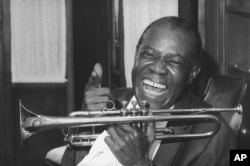Think about jazz, and soulful Billie Holiday, mesmerizing Ella Fitzgerald and charismatic Louis Armstrong probably come to mind. They are among some of America's great jazz singers being highlighted in a new exhibit at the Library of Congress in Washington, D.C.
Rare photographs and videos, along with personal notes and drawings, provide a glimpse into the complexity of these artists from the1920s through today. Although many of them, like Bessie Smith, Chet Baker, and Anita O'Day, have passed away, their musical legacies live on.
Larry Appelbaum, the library's jazz specialist and curator of the exhibit, said Holiday's songs about sadness and heartache mirrored her tumultuous life. When she emotes, he said, "you can feel something beyond the feeling of the lyric. You can hear her, and you can feel her."
Different styles, different voices
Jazz singers have interpreted a wide range of music from dance tunes to popular songs to original music. Their styles, Appelbaum said, are as distinctive as their voices.
"They swing,” he said. “By swing, I mean it's an approach to tempo and time. It's the thing that makes you snap your fingers or tap your foot. They improvise. Sometimes they'll phrase like an instrument. Sometimes they'll employ what we call scat — syllables instead of the lyrics."
He points to Ella Fitzgerald — a remarkable vocalist whose career spanned six decades — as the quintessential scat singer.
"Instrumentalists would be working with her and she would go out and sing a scat chorus using these nonsense syllables and she would be phrasing just like a saxophone or just like a trumpet," he said.
Jazz — an original American art form — began with African-American ensembles in New Orleans about the turn of the last century. But it was Louis Armstrong, renowned trumpeter and gravely-voiced singer, who transformed jazz in the1920s by including a soloist, changing the rhythms, and making it swing.
"He did it in such a way that no one had ever heard anything like it before," Appelbaum explained.
Appelbaum considers the 1950s to be the golden age for jazz singers. Among them was pianist and vocalist Shirley Horn, who performed into the early 2000s.
"She would sing in a quiet voice, using the space between notes. She would interpret these songs in a very moving, emotional way," Appelbaum said.
Vocalist Abbey Lincoln and her husband, jazz drummer Max Roach, became involved in the civil rights struggle in the 1960s. Both African-Americans, Appelbaum said they created music "that expressed profound fundamental statements" about the movement.
Exhibit visitor Arnold DeVille recalled watching famous jazz singers — especially the very popular Louis Armstrong — perform on television in the ‘60s.
"Brings back memories of when I was growing up, where my uncles and aunts would be dancing in our home, just having fun enjoying themselves," DeVille said.
21st century jazz
The exhibit also features some of the new generation of jazz artists — Esperanza Spaulding, Gregory Porter and Cecile McLorin Salvant — all of whom have won Grammy awards for best jazz vocal album.
"It's not so much that they're singing what their parents liked, although there's always an audience for that," Appelbaum said, "it's are they singing about themes, and subject matter that are important for younger audiences."
Past and present, they are keeping jazz alive for generations to come.















